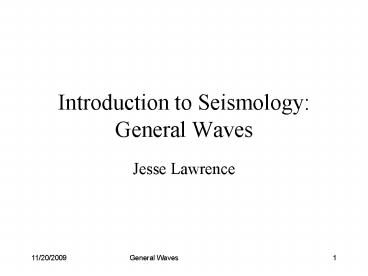Introduction to Seismology: General Waves
1 / 16
Title:
Introduction to Seismology: General Waves
Description:
... disturbance or variation that transfers energy progressively from point to point ... 11/9/09. General Waves. 12. Kinetic Energy: Kinetic Energy: For a string: m ... –
Number of Views:45
Avg rating:3.0/5.0
Title: Introduction to Seismology: General Waves
1
Introduction to SeismologyGeneral Waves
- Jesse Lawrence
2
What is a wave?
- Wave A disturbance or variation that transfers
energy progressively from point to point in a
medium and that may take the form of an elastic
deformation or a variation of pressure, electric
or magnetic intensity potential or temperature. - -Websters Dictionary
3
What is a wave?
- Seismic Wave An elastic deformation that
transfers energy progressively from point to
point in a medium.
4
Harmonic Wave Solution
- Any function of the form f(x?vt) describes a
propagating wave as a function of time and
distance - where x is distance, v is velocity,
- t is time, A is amplitude, ? is
- angular frequency, and k is
- wavenumber.
5
Velocity, Period, Frequency
6
A Plucked String
- If you pluck a string that is lengthwise in the x
direction by applying a tension, ?, in the y
direction, the force balance between the string
and applied force is
7
Transmitted and Reflected Waves
- Left Side
- Right Side
A
C
B
8
Transmitted and Reflected Waves
A
C
B
9
Reflection Transmission Coefficients
- Reflection coefficient
- Transmission coefficient
- Reciprocal for orthogonal incidence
A
C
B
10
Fixed-End Free-End Reflections
- Normal Reflection
- Fixed-End Reflection
- Free-End Reflections
11
Reflected Transmitted Wavelengths
12
Kinetic Energy
- Kinetic Energy
For a string m ?dx
average over 1 wavelength 0 - ?
Identity
13
Potential Energy
- Strain
- Potential Energy
- Total Energy
(using the Taylor series approximation (1a2)1/2
1 a2/2 for small a)
? is tension.
14
Propagating Wave Normal Mode
- Propagating wave solution
- Normal Mode
15
Traveling Wave
- Traveling wave
- The modes are orthogonal, so
- The amplitude depends on the frequency
xs source location
16
Traveling Wave
- The summation of all frequencies results in
- Destructive interference
- Constructive interference































